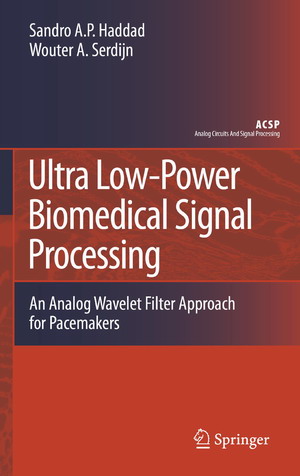Ultra Low-Power Biomedical Signal Processing
发布时间:2012-4-24 15:54
发布者:看门狗
关键词:
信号处理
|
Ultra Low-Power Biomedical Signal Processing - An Analog Wavelet Filter Approach for Pacemakers Series: Analog Circuits and Signal Processing Haddad, Sandro A.P., Serdijn, Wouter A. 2009, X, 218 p., Hardcover ISBN: 978-1-4020-9072-1 
About this book Ultra Low-Power Biomedical Signal Processing describes signal processing methodologies and analog integrated circuit techniques for low-power biomedical systems. Physiological signals, such as the electrocardiogram (ECG), the electrocorticogram (ECoG), the electroencephalogram (EEG) and the electromyogram (EMG) are mostly non-stationary. The main difficulty in dealing with biomedical signal processing is that the information of interest is often a combination of features that are well localized temporally (e.g., spikes) and others that are more diffuse (e.g., small oscillations). This requires the use of analysis methods sufficiently versatile to handle events that can be at opposite extremes in terms of their time-frequency localization. Wavelet Transform (WT) has been extensively used in biomedical signal processing, mainly due to the versatility of the wavelet tools. The WT has been shown to be a very efficient tool for local analysis of non-stationary and fast transient signals due to its good estimation of time and frequency (scale) localizations. Being a multi-scale analysis technique, it offers the possibility of selective noise filtering and reliable parameter estimation. Often WT systems employ the discrete wavelet transform, implemented on a digital signal processor. However, in ultra low-power applications such as biomedical implantable devices, it is not suitable to implement the WT by means of digital circuitry due to the relatively high power consumption associated with the required A/D converter. Low-power analog realization of the wavelet transform enables its application in vivo, e.g. in pacemakers, where the wavelet transform provides a means to extremely reliable cardiac signal detection. In Ultra Low-Power Biomedical Signal Processing we present a novel method for implementing signal processing based on WT in an analog way. The methodology presented focuses on the development of ultra low-power analog integrated circuits that implement the required signal processing, taking into account the limitations imposed by an implantable device. Written for: Academic and industrial researchers in signal processing, electronic circuit design, low-power circuit design, biomedical circuits and systems; graduate students in electrical engineering, computer engineering and biomedical engineering  Ultra_Low_Power_Capacitive_Sensor_Interfaces.pdf
(3.22 MB)
Ultra_Low_Power_Capacitive_Sensor_Interfaces.pdf
(3.22 MB)
|





网友评论